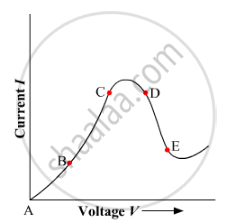Advertisements
Advertisements
प्रश्न
Name the unit of electrical resistance and give its symbol.
उत्तर
The SI unit of electrical resistance is ohm and its symbol is Ω.
APPEARS IN
संबंधित प्रश्न
Graph showing the variation of current versus voltage for a material Ga As is shown in the figure. Identify the region of
(i) negative resistance
(ii) where Ohm's law is obeyed.

A low voltage supply from which one needs high currents must have very low internal resistance. Why?
What is Resistivity?
The graph between V and I for a conductor is a straight line passing through the origin.
What should remain constant in a statement of this law?
What is the necessary condition for a conductor to obey Ohm’s law?
An electric bulb draws 1.2 A current at 6.0 V. Find the resistance of filament of bulb while glowing.
In an experiment of verification of Ohm’s law following observations are obtained.
|
Potential difference V (in volt) |
0.5 | 1.0 | 1.5 | 2.0 | 2.5 |
| current I (in ampere) | 0.2 | 0.4 | 0.6 | 0.8 | 1.0 |
Draw a V-I graph and use this graph to find:
- the potential difference V when the current I is 0.5 A,
- the current I when the potential difference V is 0.75 V,
- the resistance in a circuit.
Answer the following question.
Distinguish between Ohmic and non-ohmic substances; explain with the help of example.
The resistance of a nichrome wire at 0°C is 10Ω. If its temperature coefficient of resistivity of nichrome is 0.004/ °C, find its resistance of the wire at boiling point of water. Comment on the result.
Two cells each of 5V are connected in series across an 8Ω resistor and three parallel resistors of 4Ω, 6Ω, and 12Ω. Draw a circuit diagram for the above arrangement. Calculate
- the current drawn from the cell
- current through each resistor
